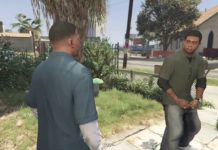Platforms: PS4 (review code provided), Xbox One, PC
Publishers: Electronic Arts
Developers: Ghost Games
Introduction
Being thrust into the open world of Fortune Valley for the first time was a great experience. I was on an airport runway, surrounded by ramps to jump off of, and miles upon miles of road in all directions. I started to explore a bit and that little pleasure center whenever I boot up any of the Forza Horizon games immediately activated. Ghost Games have built a Need for Speed game with a map that’s ripe for exploring, racing, drifting, and pulling crazy stunts in. All I wanted was to keep exploring this vast map, but I was constantly being reminded that there are two story missions waiting for me to start. I wanted to resist and keep on exploring, but I also wanted to earn some cash, maybe buy some new cars or upgrade mine. This is where, and excuse my French, the sh*t hit the fan.

NFS never felt this good
Before I get into the parts that unfortunately sour the NFS experience, I first want to talk about the good stuff. Because despite me not enjoying the progression system found in NFS, I genuinely loved the driving. Each NFS game feels slightly different from one another. Since the game is built around being an Arcade racer, throwing any notion of simulation out of the window, each dev tackled the arcade feel a little different. Ghost Games have so far developed Need for Speed Rivals and the 2015 Need for Speed reboot, both titles which offered slight changes to how cars handle. I can safely say that with Payback, they absolutely nailed it.
Everything from tackling corners at high speed to how drifts are initiated and then held for as long as possible feels perfect. The sense of speed might be somewhat lacking, which is a shame, but the actual handling of each car more than makes up for it. And while the sense of speed when slamming down on the gas didn’t feel as good, the nitrous once again felt like it gave you an advantage, rather than literally boosting everyone around you whenever you used it. If anything, using nitrous in Payback is almost key to securing a good placement in a race.
A little bit of Fast & Furious sprinkled in
It’s no surprise that at this point, EA wants to differentiate themselves from other racing games by including a narrative. Need for Speed 2015 featured a live-action cast that hammed it up any chance they got. It was a silly story but tied the experience together. It was definitely cheesy, but I remember not minding it. It was silly. Payback is similar in that it tries to tie the whole experience together by offering a pretty serious story, which unsurprisingly, revolves around getting revenge.
This time, the actors are all rendered in-game, no live-action moments here. As much crap as NFS 2015 got for its cheesy live-action segments, I sort of wish Payback stuck with them, but given the intense stunts that needed to be pulled off, like jumping from a car to a truck moving at top speed, it’s not surprising that the devs opted to use in-game characters this time.
Your crew is made up of Tyler, the racer, Mac, the drift and off-road specialist and Jessica, the getaway driver who somehow hasn’t been arrested yet. They’re all pretty bland, with maybe the exception of Mac, who is genuinely more likable than the other two.
The whole premise is rather silly, with your crew stealing a car from a high profile gambler, then the car gets stolen from you, and you join up with said gambler to take revenge. It’s especially silly considering that six months pass after you agree to work for the gambler, working as a valet at one of his casinos, and one of the first things your character says is that he can’t even think about joining a race because he’ll immediately be thrown into jail, only to literally join a race five minutes later.

Stuntman, this isn’t
A part of the appeal for Payback, at least during its initial showings, was the promise of allowing gamers to partake in these huge spectacles, the set pieces that revolve around crazy stunts. Turns out, EA or Ghost Games thought that would have been too difficult for us, and lets the game do all the work. One of the earliest examples of this is when you’re in the process of stealing the car from the gambler. During the race, one of your crewmembers drives up a truck to a location that will act as a ramp, so you can make your escape. As soon as you reach the truck, you immediately lose control and the game goes into cutscene mode. Yeah, the jump looks fantastic, but it didn’t feel earned. I was excited to aim for that jump and cross my fingers to make it, but the game took that feeling completely away. Sadly, this extends to all the major set pieces in the game.
When it comes to cops, I’ll be the first to admit I never really loved trying to get away from them when roaming the open world. Thankfully, they’re nowhere to be found when simply exploring, and that’s great. However, when it came to escaping from the police in story missions, I somewhat enjoyed the improv driving required to lose them. In Payback, that improvisation is completely gone. Instead, you’ll need to simply follow a set path highlighted by checkpoints. Reach the end and you’ve somehow, inexplicably, escaped from the pursuit.

The real buzzkill
Payback’s complete overhaul of upgrading cars is one of the worst design decisions I’ve seen when it comes to this franchise. It all revolves around Speed Cards, a random reward you get for completing a race., which can fill one of six spots on your car. Each of these parts also have a manufacturer type as well as a bonus state attached to them. Applying these Speed Cards to your car will marginally raise its level as well as some of its stats, depending on what card you’re slotting in, and matching the same manufacturer three times provides an even bigger bonus. There are in-game shops that allow you to purchase Speed Cards without relying on RNG, but never enough of the same manufacturer (at least in my experience) to get that bonus, and they’re pretty expensive, which means you’ll have to grind more races either way to have enough.
There is another ‘less random but still pretty random’ way to obtain more Speed Cards, and that’s by exchanging three Part Tokens for a single Speed Card. You can set one of three parameters: the Manufacturer, the component, or the bonus stat. By choosing one, the other two will be random, which means even if you’re going for the three manufacturer bonus, you could still end up getting a Speed Card for a component you already have, making it useless. You could turn that part back into a Token, but that means you’ve wasted three, only to get one back.
The way this ties to progression is that each mission has a suggested level requirement. If your car is below that level, expect to get absolutely smoked. I’ve been able to beat a race (barely) being two levels under, but it’s clear that there is some sort of difficulty modifier being applied whenever you’re not at the appropriate level. Your car never really feels faster by upgrading it, it just seems like your opponents are either letting you pass them at certain points of the race or making dumb mistakes when your car is higher than the recommended level. It doesn’t feel organic, and it certainly doesn’t feel rewarding.
It’s especially sad to see given Forza Horizon’s perfect answer to this sort of problem. If your car isn’t tuned up to be able to race against specific cars in a race, you can simply pay in-game credits, and your car gets a significant upgrade. It’s never too expensive and always convenient enough to keep you playing new events. In Payback, it seems like you’re constantly being encouraged to replay races you’ve already beat with the hopes of earning better Speed Cards at random, or getting enough credits and hope the in-game shop has the one you need.
What’s even more depressing, given that the cars available in-game are all begging to be driven, is that this upgrade system actively discourages you to drive them, because then you’re once again stuck, replaying older missions or races in order to get Speed Cards, since they don’t easily transfer from car to car.

Conclusion
Based on its world and racing alone, Need for Speed Payback was a lot of fun. I thoroughly enjoyed Fortune Valley, even though it still pales in comparison with the likes of Horizon 2’s European France/Italy setting or Horizon 3’s Australian inspired setting. It’s also clear Payback was influenced by Horizon’s map design by sprinkling various Drift Zones and Speed Traps to keep players occupied with events while driving from point A to point B, not to mention Derelict Cars which must be found and then repaired in order to drive.
But where Payback really disappointed is in its progression system. I miss the days of simply driving to races, placing, earning money, using that money to upgrade my car and in turn winning more difficult races. Customizing your car is fun and achievable in this game with some really sweet designs, but it was hard to focus on making my car look awesome when all I could think about is raising it another 30 levels in order to even compete in the next race.






